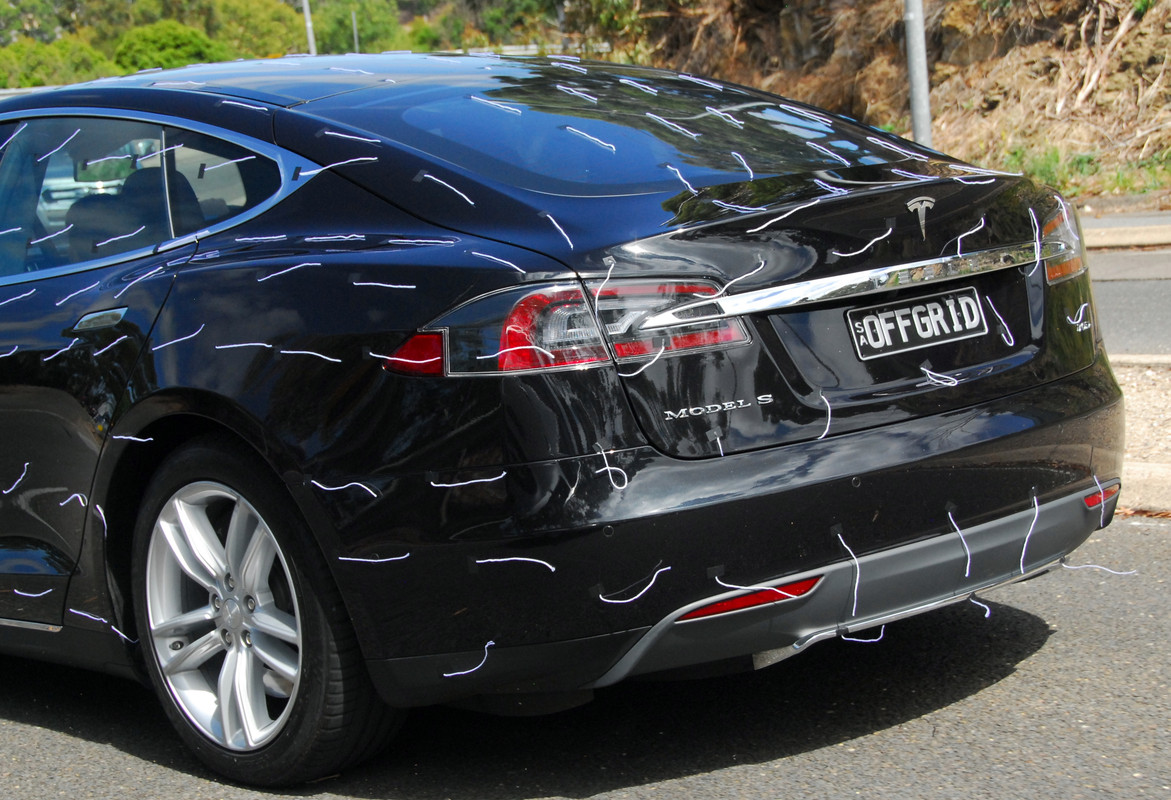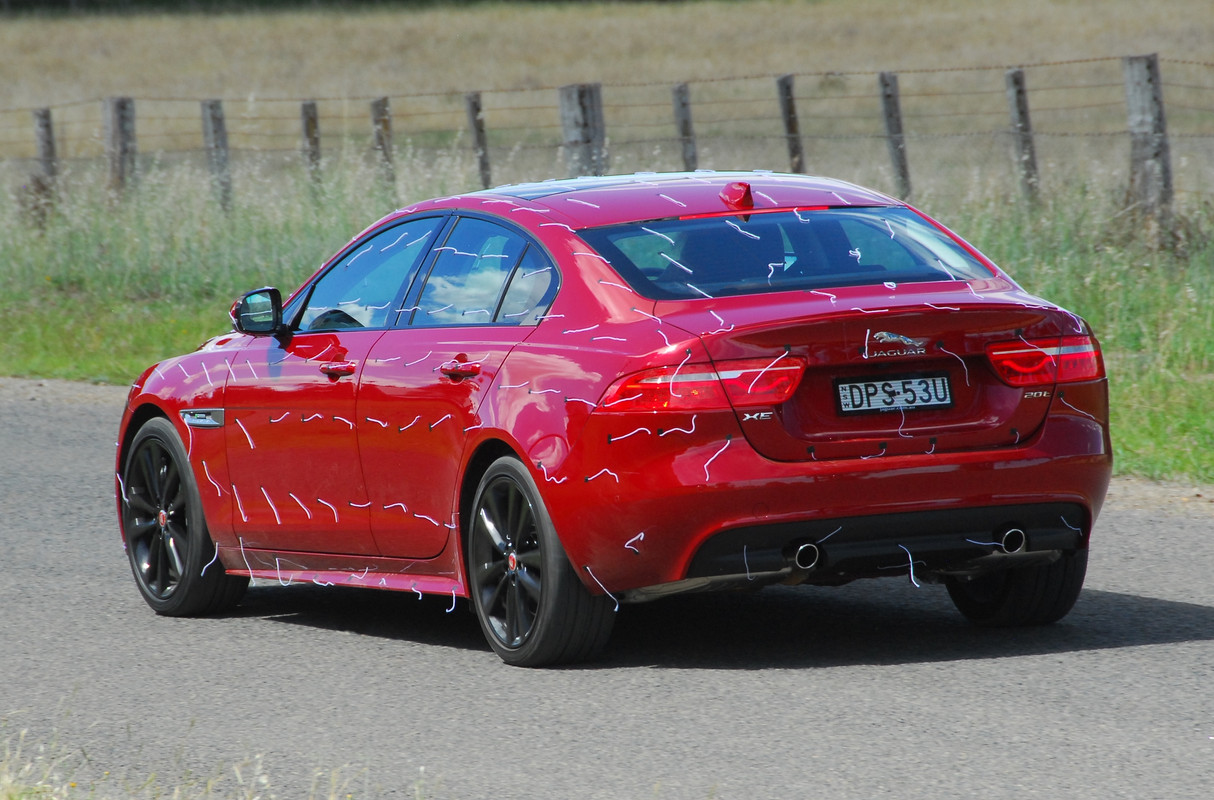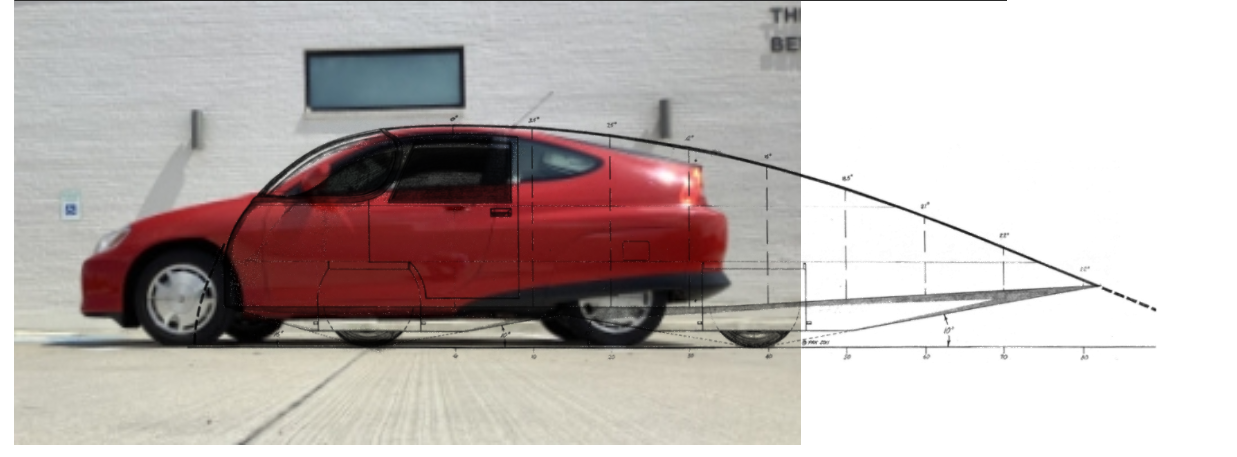 08-28-2020, 11:47 PM
08-28-2020, 11:47 PM
|
#81 (permalink)
|
|
Cyborg ECU
Join Date: Mar 2011
Location: Coastal Southern California
Posts: 6,302
Thanks: 2,374
Thanked 2,176 Times in 1,471 Posts
|
Quote:
Originally Posted by Vman455

... Is that what you're asking?
|
Yes, in part. And thanks, Vman455. That helps. Why do you think pressure readings are higher on this fastback’s roof than on the notchback roof? Why is the pressure higher or about the same on the rear of the fastback body?
Figure 4 in this same article shows the fastback with slightly higher Cd than the notchback, too. But if fastbacks are inferior for drag too, then why are so many low drag vehicles kinda in the fastback shape? The Tesla Model S, the Prius, and the Gen 1 Insight are the most obvious examples. Why aren't those cars notchbacks? One can optimize a fastback to bring down lift (e.g. a well-tuned undertray & diffuser), but why start with a higher lift and higher drag shape in the first place if ALL of them are supposedly so inferior? What's the advantage of a fastback? Cargo area?!
__________________
See my car's mod & maintenance thread and my electric bicycle's thread for ongoing projects. I will rebuild Black and Green over decades as parts die, until it becomes a different car of roughly the same shape and color. My minimum fuel economy goal is 55 mpg while averaging posted speed limits. I generally top 60 mpg. See also my Honda manual transmission specs thread.


Last edited by California98Civic; 08-30-2020 at 10:00 AM..
Reason: corrected Vman455
|
|
|

|
|
The Following User Says Thank You to California98Civic For This Useful Post:
|
|
 Today Today
|
|
|
|
 Other popular topics in this forum...
Other popular topics in this forum...
|
|
|
|
 08-29-2020, 02:43 AM
08-29-2020, 02:43 AM
|
#82 (permalink)
|
|
Banned
Join Date: Nov 2017
Location: Australia
Posts: 2,060
Thanks: 107
Thanked 1,608 Times in 1,137 Posts
|
Quote:
Originally Posted by California98Civic

Figure 4 in this same article shows the fastback with slightly higher Cd than the notchback, too. But if fastbacks are inferior for drag too, then why are so many low drag vehicles kinda in the fastback shape? The Tesla Model S, the Prius, and the Gen 1 Insight are the most obvious examples. Why aren't those cars notchbacks? One can optimize a fastback to bring down lift (e.g. a well-tuned undertray & diffuser), but why start with a higher lift and higher drag shape in the first place if ALL of them are supposedly so inferior? What's the advantage of a fastback? Cargo area?!
|
The big issue with fastback shapes is the generation of strong trailing vortices off the inclined pillars. (As far as I am aware, CFD is still not very good at showing the effect of these.)
So for example, Rob Palin (Tesla aerodynamicist on the Model S) told me he spent a lot of wind tunnel time in changing the shape of the C pillar (A pillar, too) to reduce vortex development.
Because of the small wake that can be developed by a fastback, drag can be low - if the trailing vortex development of the fastback shape is heavily optimized.
(I think we will see a return to fins on fastback shapes - I am convinced that, based on my measurements on my Insight, their presence can reduce trailing vortex strength.)
In addition, because there is good attached flow down fastback shapes, a rear spoiler can increase pressures on the rear hatch / boot (so decreasing drag, because there is a forward component to the force developed) - and the spoiler can be designed so that the wake is not increased in size.
In summary, I think - as shown by the cars you mention - fastback shapes can be very low in drag, but it's not all that simple to get them right. |
|
|

|
 08-30-2020, 10:04 AM
08-30-2020, 10:04 AM
|
#83 (permalink)
|
|
Cyborg ECU
Join Date: Mar 2011
Location: Coastal Southern California
Posts: 6,302
Thanks: 2,374
Thanked 2,176 Times in 1,471 Posts
|
But it is not a CFD study. The author used pressure taps on a 1:4 scale model developed by BMW/Audi and tested it in a wind tunnel. The flow visualizations were done with paint on the body in the wind tunnel. Everything about the two shapes is standard except the slope of the roof/backlight/trailing edge.
That the modest change in the slope angle and curves on the fastback yields higher pressure readings on the roof is interesting. If the pressure readings along the backlight and decklid drop quickly to lower than the notchback, might it be possible that this particular fastback becomes too fast after the roof AND that the pillars are not optimized well?
If the vortices are the problem and the fastback shape is otherwise known to have more potential for reducing drag and lift when undertrays, diffusers, spoilers, and fins are used, then why not explore reducing the vortices off the pillars by tapering and radiusing the fastback's full rear body contours more? We might be able to get Cd possibly under 0.20 and lower lift too.
That kinda is a description of the XL1, which even narrowed the rear track. The XL1 was speed limited possibly because of higher lift over 100 MPH. But lift at high speeds could be dealt with through other optimizations or active aero. We'd have an ultra low drag body and no lift problems at 150 MPH.
I would love to find a contemporary study in automotive aerodynamics where some grad student tests an abductively reasoned thesis like this.
Here again is the link to the article (I previously posted it in post #58):
https://ecomodder.com/forum/showthre...tml#post630095
__________________
See my car's mod & maintenance thread and my electric bicycle's thread for ongoing projects. I will rebuild Black and Green over decades as parts die, until it becomes a different car of roughly the same shape and color. My minimum fuel economy goal is 55 mpg while averaging posted speed limits. I generally top 60 mpg. See also my Honda manual transmission specs thread.


|
|
|

|
|
The Following User Says Thank You to California98Civic For This Useful Post:
|
|
 08-30-2020, 05:03 PM
08-30-2020, 05:03 PM
|
#84 (permalink)
|
|
Banned
Join Date: Nov 2017
Location: Australia
Posts: 2,060
Thanks: 107
Thanked 1,608 Times in 1,137 Posts
|
Quote:
Originally Posted by California98Civic

We might be able to get Cd possibly under 0.20 and lower lift too.
We'd have an ultra low drag body and no lift problems at 150 MPH.
|
Porsche Taycan isn't far off that. Fastback shape, 0.22 Cd in Range mode, 0.02 CLr in Performance mode (ie rear spoiler up), 162 mph top speed. |
|
|

|
|
The Following 2 Users Say Thank You to JulianEdgar For This Useful Post:
|
|
 08-30-2020, 06:57 PM
08-30-2020, 06:57 PM
|
#85 (permalink)
|
|
Banned
Join Date: Nov 2017
Location: Australia
Posts: 2,060
Thanks: 107
Thanked 1,608 Times in 1,137 Posts
|
Quote:
Originally Posted by California98Civic

If the vortices are the problem and the fastback shape is otherwise known to have more potential for reducing drag and lift when undertrays, diffusers, spoilers, and fins are used, then why not explore reducing the vortices off the pillars by tapering and radiusing the fastback's full rear body contours more?
|
I am not sure that is the best approach. In many cases, it appears more to be the shape of the C-pillars. I don't know of any comparative testing that has been published, but just by observation it's my guess (and only a guess) that C pillar designs that prevent airflow wrapping around the pillar onto the rear window reduce the strength of the vortices on fastback shapes. In other words, the more the airflow can be kept travelling longitudinally, the better.
If you look at the XL1, you can see this may well occur:

My tuft testing of the Tesla Model S shows this occurring:

..and the rear view shows the shape of the pillars well.

The Taycan is very similar:

Contrast that with my tufting of the XE Jaguar, for example, where you can clearly see airflow wrapping around the smoothly curved pillars:

...and look at how low the pressures are on the upper part of the rear pillars
(hotter colour = lower pressure).

(And if you look at the tuft and CFD images of the Jaguar, you can see - of course - that lift is created by the attached airflow... and not some weird theory that separation is responsible for lift on these shapes.)
|
|
|

|
|
The Following 2 Users Say Thank You to JulianEdgar For This Useful Post:
|
|
 08-31-2020, 12:13 AM
08-31-2020, 12:13 AM
|
#86 (permalink)
|
|
Master EcoModder
Join Date: Aug 2012
Location: northwest of normal
Posts: 29,405
Thanks: 8,362
Thanked 9,123 Times in 7,533 Posts
|

This one tells the story. The difference in contour to the Jaguar is subtle but it appears to be rolling the air downward instead of up and inward. Mainly a separating edge.
I wonder if the external gutters on my Superbeetle act like a fence? Hard to know without shaving one side. 
__________________
.
.Without freedom of speech we wouldn't know who all the idiots are. -- anonymous poster
___________________
.
.tragectory: Line goes down and to the right.
|
|
|

|
 08-31-2020, 11:05 PM
08-31-2020, 11:05 PM
|
#87 (permalink)
|
|
Banned
Join Date: Nov 2017
Location: Australia
Posts: 2,060
Thanks: 107
Thanked 1,608 Times in 1,137 Posts
|
Incidentally, note the shape of the Tesla Model S versus The Template.

See all that separated flow down the rear window?

Me neither. |
|
|

|
|
The Following User Says Thank You to JulianEdgar For This Useful Post:
|
|
 09-01-2020, 12:48 AM
09-01-2020, 12:48 AM
|
#88 (permalink)
|
|
Banned
Join Date: Nov 2017
Location: Australia
Posts: 2,060
Thanks: 107
Thanked 1,608 Times in 1,137 Posts
|
OMG, here's another.


How can the Jaguar possibly have attached flow on the rear window (albeit with a small centre/lower separation bubble.)
I mean the spoiler doesn't even 'reach up' to the right level! How on earth can the Jaguar generate positive pressures on the rear boot when it all should be in separated flow?
Anyone might think - gasp - that The Template is a complete crock. No, that would never do.... |
|
|

|
|
The Following User Says Thank You to JulianEdgar For This Useful Post:
|
|
 09-01-2020, 01:16 AM
09-01-2020, 01:16 AM
|
#89 (permalink)
|
|
Master EcoModder
Join Date: Aug 2012
Location: northwest of normal
Posts: 29,405
Thanks: 8,362
Thanked 9,123 Times in 7,533 Posts
|
Thee Template might work.... if people respected the frontal elevation. A unitary half-circular arc. Nobody got time for that. Plymouth[?] made a concept roadster with a half-circular windshield header [citation needed, I know] and they found it messes with the passenger's head room.
I started a thread Why does The Template have to be a half body of revolution? in 2012[!] to address it's problems.
Another counterexample is the GM EV1. It has a too-fast fastback and too-good numbers.
__________________
.
.Without freedom of speech we wouldn't know who all the idiots are. -- anonymous poster
___________________
.
.tragectory: Line goes down and to the right.
|
|
|

|
 09-01-2020, 03:34 AM
09-01-2020, 03:34 AM
|
#90 (permalink)
|
|
Banned
Join Date: Nov 2017
Location: Australia
Posts: 2,060
Thanks: 107
Thanked 1,608 Times in 1,137 Posts
|
I am thunderstruck. Just gobsmacked. Amazed, astonished, flabbergasted. Words fail me in my sheer astonishment.
The Gen 1 Honda Insight doesn't match The Template.
How could Honda engineers have possibly made this mistake? My gosh; what fools they must be.

So of course the Insight would have separated flow on the rear hatch, wouldn't it?
But it doesn't...

|
|
|

|
|